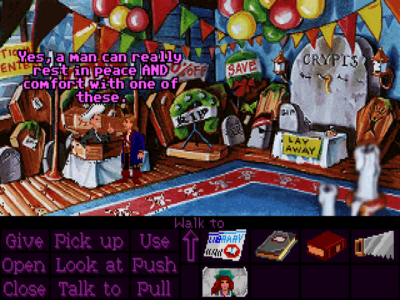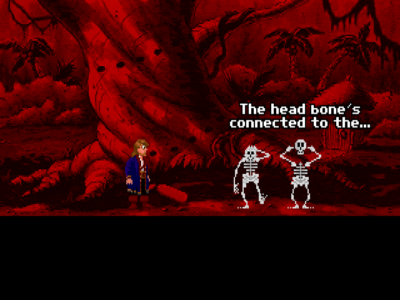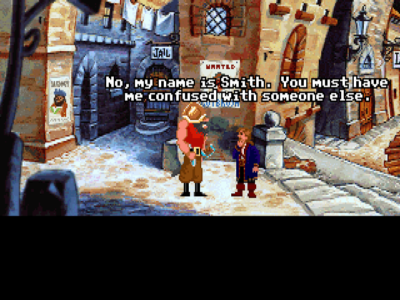
Monkey Island 2: LeChuck’s Revenge
Written by: Rik
Date posted: February 24, 2007
- Genre: Adventure
- Developed by: LucasArts (Lucasfilm Games)
- Published by: LucasArts (Lucasfilm Games)
- Year released: 1991
- Our score: 9
When discussing the Monkey Island games, it’s traditional to make mention of the perceived divide between the first two and the latest two titles in the series. Some are of the opinion, for example, that numbers one and two were the coherent vision of the series’ lovable designer-creator and numbers three and four were cooked up in a boardroom by a bunch of hateful, sneering execs. Whether this point of view is fair or not (official FFG stance: it’s not), there’s no escaping the fact that the first two games are genuine oldies, pre-talkie point-and-clickers, while the later games make use of video cut-scenes, speech spooled from a CD and all kinds of new-fangled jiggery-pokery. One way or another, the divide kind of makes sense.
There follows a general assumption that the Ron Gilbert-era games were available to be enjoyed by all, on a variety of formats. As ever, this point of view conveniently overlooks the plight of the lepers of the 16-bit gaming world, Atari ST owners, who never got the chance to play this delightful sequel on their wonderful (if slightly underpowered) machine. There was hell to pay in the letters page of ST Format once LucasArts made the announcement – unfortunately, though, the only people reading it were other ST owners. Still, this isn’t just about the machine I used to own being ignored – I mean, what about the terrible injustice created by the absence of a (consults MobyGames) Sega CD version of this game? It’s a scandal, I tell you.
Anyway, I basically missed this one first time around, although I did at some stage manage to grab a few hours playing on a pirated copy on my Dad’s work PC (accompanied by the sound of the power-supply fan and a few awful PC-speaker noises). So, while I may not have had the same rosy feeling of nostalgia turning quite as many ‘happy lights’ on in my head during this game as with the original, in a way the unhealthy excitement at playing a less-than-familiar Monkey Island title was more than adequate compensation.
At the end of the first game (look away now if you haven’t finished it), intrepid wannabe pirate Guybrush Threepwood had achieved everything your typical everyday hero would want to achieve: he beat the bad guy and got the girl. Unfortunately, though, it seems that he somehow contrived to mess it all up for himself, and at the beginning of this game we find him much the same as before – at the start of a barmy quest to make a name for himself as a pirate.
The goal this time around is to search for the legendary treasure known as ‘Big Whoop’. As always, this isn’t a simple task, and with the location of the treasure long remaining a secret, a map-less Guybrush finds himself chasing dead ends on the appropriately named Scabb Island. Not only is the place a scummy hell-hole, the whole place is controlled by a nasty little man by the name of Largo LaGrande and you’ll need to loosen his grip on power before you can even leave the island (see Walkthrough: The Largo Embargo for some hints and tips). Needless to say, there are a few other complications along the way, and, as suggested by the game’s title, this includes the return of the dreaded zombie pirate LeChuck.

Stan’s moved out of the used ship game and into the second-hand coffin market. You won’t have to try so hard to wangle a deal out of him this time around, though.
Clearly, there was little need to tinker with the phenomenally successful formula of the original, and as a game, Monkey Island 2 contains all the same elements that made the first one such a hoot to play. Again, the story and dialogue are both excellent, with the oddball characters you meet along the way providing plenty of entertainment value during conversations. The puzzles, if anything, are a bit tougher than in the first game; for a start, there’s a lot of running around during the middle of the game when you’re searching three different islands for pieces of the ‘Big Whoop’ treasure map, and there are some occasions where you’ll need to employ a little lateral thinking in order to progress. Though fans of ‘insult sword fighting’ will be disappointed by its absence here, there are still plenty of clever touches which lift the game above your usual ‘use this object on another object’ adventure. Many situations need you to solve more than one puzzle to progress: during the spitting contest on Booty Island, for example, you’ll actually need to cheat in three different ways before you can progress. Though this might be a bit irritating at the time, especially if you think you’ve cracked a puzzle when you haven’t, it’s certainly preferable to having only one obvious (or obscure) solution for each situation.
From a technical standpoint, barring some rudimentary improvements to the interface, it’s basically the same game underneath. The difference between the two will be more obvious to those who played the original EGA release of the first game (rather than the updated VGA version – reissued in compilations – that I played for the review) so be prepared to adjust your expectations accordingly. As with the original, it certainly isn’t the greatest looking game in the world, but it still looks pretty good for its age, and (most importantly) the characters and locations retain their original charm. The sound is pretty sparse, with spot effects only occasionally evident (most notably during the above-mentioned spitting contest). The music, of course, is great, although I was again slightly disappointed by the CD versions of the various tunes and occasionally found myself pining for the MIDI originals.

An odd dream sequence. Pay attention, though; it’s all part of a clue to a puzzle, which you’ll need later on.
Overall, Monkey Island 2 is certainly a worthy sequel, and I have absolutely no hesitation in recommending it to anyone with even a passing interest in adventure games. However, eagle-eyed readers may have noticed that (unlike the original) it fails to get top marks. Though hardly an earth-shattering event in itself, it is, I suppose, mildly controversial, and nevertheless warrants an explanation. There aren’t any flaws in the game particularly, but personally speaking, I have to say that I found it ever so slightly less enjoyable to play than its predecessor.
Firstly, the tone of the game is noticeably darker this time around. Where Guybrush used to be an eager, wide-eyed innocent, he is now a pompous dimwit with an inflated sense of his own importance, and this in itself affects the way your character interacts with others. While there is certainly plenty of comedy mileage in this, the humour generally has a nastier, darker edge to it than in the first game and I personally didn’t enjoy it as much. The story, too, takes a few surreal twists and turns, culminating in a weird and (for me) slightly disappointing ending. I know for a fact plenty of people disagree with me on both of these points, and this is very much down to personal preference, but seeing as I’m in charge for the duration of this review, it’s going to count against the game here I’m afraid.
Secondly, the bulk of the action is spread across three islands, none of which are particularly flush with locations or characters, and you certainly seem to have less of a chance to stop and chat than in the previous game. Again, some people may prefer to spend less time going down dialogue trees that aren’t particularly plot specific, but for me, this has to go down as another (slight) negative.
But enough of all that. While both points are significant enough to be worth mentioning, they shouldn’t in any way detract from the fact that Monkey Island 2 is a fantastic game and a fantastic sequel. As an adventure game, it’s still head and shoulders above virtually everything else out there and is certainly worthy of every self-respecting gamer’s attention. Just be sure to check out the original first.




 Posts
Posts